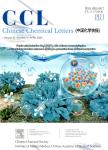Organic dyes containing fused acenes as building blocks: Optical, electrochemical and photovoltaic properties
Organic dyes containing fused acenes as building blocks:Optical,electrochemical and photovoltaic properties作者机构:Laboratory of Advanced Functional Materials Xiamen Institute of Rare Earth Materials Chinese Academy of Sciences Xiamen 361024 China Laboratory for Photonics and Interfaces School of Basic Sciences Swiss Federal Institute of Technology Lausanne 1015 Switzerland
出 版 物:《Chinese Chemical Letters》 (中国化学快报(英文版))
年 卷 期:2018年第29卷第2期
页 面:289-292页
核心收录:
学科分类:08[工学] 080502[工学-材料学] 0805[工学-材料科学与工程(可授工学、理学学位)] 0703[理学-化学]
主 题:Dye sensitized solar cells Fused acene D π A 9 Phenyl carbazole Dithienopyrrole
摘 要:Two D-π-A dyes based on fused acenes(carbazole, cyclopenta[2,1-b:3,4-b']dithiophene(CPDT) and dithieno[3,2-b:2',3'-d]pyrrole(DTP)) were synthesized, characterized using UV-vis absorption spectroscopy and electrochemistry, density function theory(DFT) calculations, and used as sensitizers in dyesensitized solar cells(DSSCs). The two sensitizers were compared thoroughly over physicochemical properties and DSSC performance. Although the DTP dye has slightly blue-shifted and weaker incident photon-to-collected electron(IPCE) conversion efficiency responses, the much increased open-circuit photovoltage values and improved charge-transfer kinetics relative to the CPDT systems result in superior power conversion efficiencies. This work reveals the potential of DTP as a bridge in the design of sensitizers.



